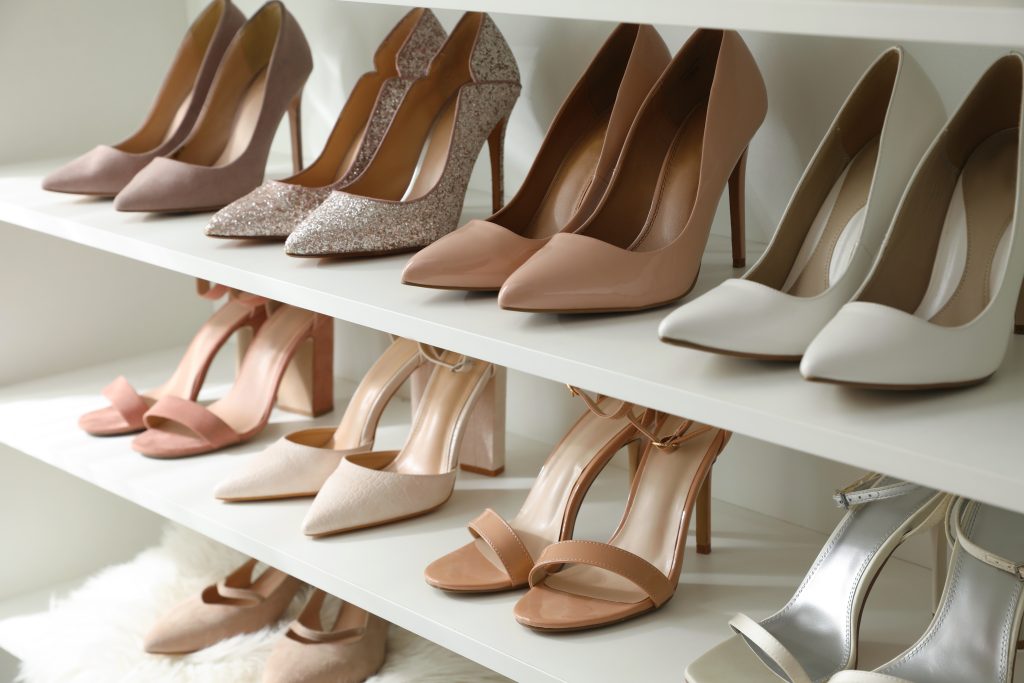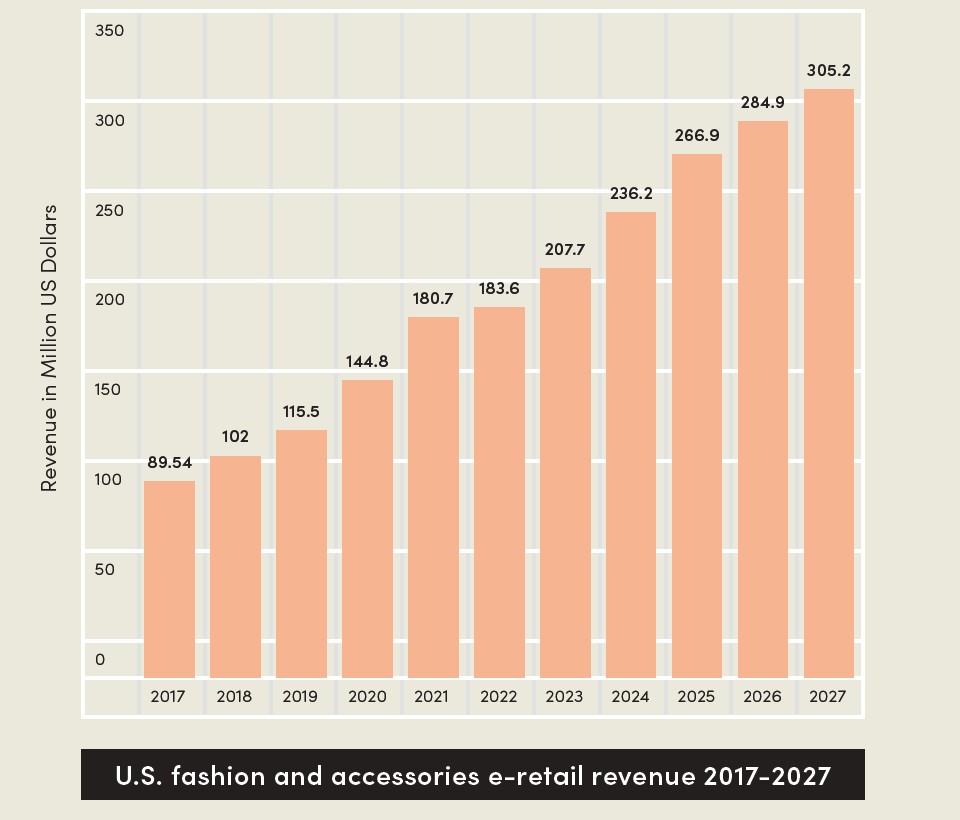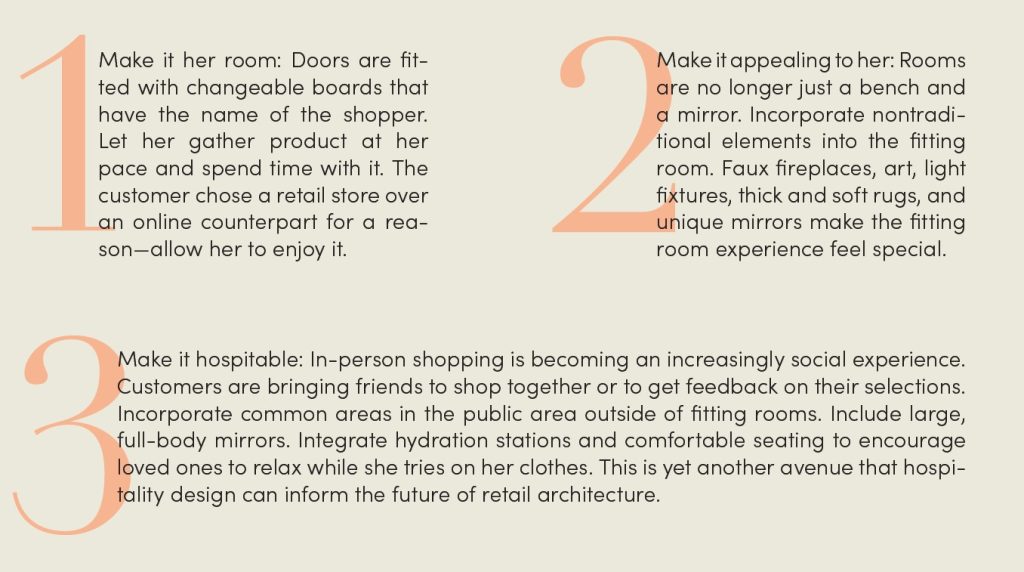The Retail Reformation
Written by Taylor Dupree Brewington
Design’s response to new challenges facing retail clothing stores.

Where did you buy your last pair of shoes?
If you asked this question to the same person in 2017 and again in 2023, you’d likely get two different answers. In six years, the online sale of shoes alone has doubled.1 Nearly all other forms of clothing have experienced a similar uptick in online sales. But the total disruption of brick-and-mortar retail stores by online marketplaces is a well-worn subject, and the numbers rarely provide any shock value in this day and age—it’s been happening since 1995 with the rise of e-commerce giants like Amazon and eBay. At this point, the dominance of e-commerce is old news.

But something new is happening.
Contrary to what many think, a customer’s conversion into an online shopper is not a total transformation. E-commerce’s growth has not signaled the death of retail—it has only changed the way customers approach the shopping experience. Market research has painted a portrait of a new type of consumer that utilizes both online and in-person shopping2, which begs the question: in a world that is becoming increasingly online, how must retailers compel and convert customers to visit an in-person store?
Do what your competitors cannot do.
Online shopping is inherently impersonal. There are no smiling faces—only customer support in the form of chatbots. There are no fitting rooms—only return labels and cardboard boxes. You cannot do it with your friends. You can see how the product looks, but you cannot see how the product makes you look.
Personality may be the secret weapon that sets brick-and-mortar apart.
With this in mind, our design team set out to research key ways to inject personality into retail stores. It began with a deep dive into a market sector that has long-prioritized the consumer experience: hospitality. Hoteliers for centuries have operated with a laser focus on providing an unforgettable experience for their customers. With a hospitality mindset guiding us, our thought process led us to ask a few questions:

From there, we sought to discover specific ways to reform traditional aspects of a retail store into opportunities for compellingly personal shopping for modern customers.
1. What draws a modern customer in?
Like it or not, in-person shopping is a highly competitive venture. Brick-and-mortar clothing stores are not only facing competition from the likes of Amazon and Etsy—they are surrounded by competitive neighbors all vying for the attention of a growing population of shopping mall customers3.
The facades of some of the world’s greatest hotels distinguish them from low-rate competitors and communicate the quality of the stay guests are sure to receive. With the same mind, retail stores must invest heavily in the outward-facing design of their storefronts. This is the retailer’s call to a customer—a transfixing visual statement that uses design to communicate aspects of a store’s brand to passing customers.
This mood should be evocative and reflective of how the customer sees herself. It can tastefully draw in current trends or even traditional holiday decor depending on the time of the year, so long as it integrates seamlessly with the brand. But keeping it distinct from neighboring stores must always remain a priority.

“This is the first thing a customer sees, and it is important to establish the mood here. The storefront communicates what a customer will experience if they step through the front doors.”
Meghan Frederick,
Studio+ Principal
2. What factors retain a modern customer’s engagement?
The customer makes it through the front door—now what? It’s not just about the product at this point. Remember: a customer only concerned with a product could just as easily find it online. To keep the customer engaged, do what hotels do: keep their senses captivated and comfortable.
Sounds
If quiet and cool are key, curated music appropriate for the store brand lays a low foundation but is kept at bay through the acoustics of the space. Lowered ceilings in intimate areas such as fitting rooms reduce noise. Furniture, rugs, and acoustic paneling dampen excess noise and ensure shopping parties can communicate easily. Meghan Frederick says “It’s important to emphasize music that is reflective of the brand and the season. Some stores may want calm and cool while other retailers want an all-out dance party.”
Sights
Lighting design in the reformed retail space is different from the harsh, direct lighting found in old department stores. The key here is careful use of indirect lighting. Recessed and ambient lighting, sconces, and chandeliers all create sufficient light to illuminate the floor while maintaining the mood established by the store entrance. We’ve found that the appropriate time to use direct lighting is via thoughtfully placed adjustable lighting around product fixtures to ensure that merchandise is visible.
Scents
All senses should be incorporated into the design and planning of the modern retail store—even smell. Modern retail spaces are finding success in creating their own unique branded scents. Initially, these fragrances are used exclusively within the store to create a familiar, welcoming effect. Over time, many brands have found success in converting their signature scents into candles, perfumes, and more. These fragrances can also be modified throughout the year to incorporate seasonal scents.
3. What convinces a modern customer to make a purchase?
The mood has been set and the experience has been established—but the sale has not yet been made. As designers and retailers deepen their knowledge of psychology, there is better insight into how sales are made. While the sales floor presents the product in a desirable way, the true decision to buy or pass on a product is made in the fitting room.
The fitting room is perhaps the most pivotal place in the brick-and-mortar shopping experience, as it is truly the one thing an online store cannot provide. Customers cannot feel, see, or share how a product looks on them. They cannot bring their friends in to share their opinions, so in this sense, online shopping becomes an isolated practice. Brick-and-mortar is social. Fitting rooms should reflect that.
Meghan Frederick had some major takeaways on the importance of the fitting room—“No matter how well-designed the store is, if a customer doesn’t feel beautiful in the product, the store will not be able to make up for that.” Thus, the fitting room must be designed to highlight the customer’s beauty and make her feel comfortable.
Meghan has transformed fitting rooms from run-of-the-mill rows of nondescript doors and unfinished concrete floors into something special. Some of her key takeaways on fitting room design include:

To thrive, retail design must lean into what makes it different.
Successful incorporation of distinguishing elements such as these elevates the brick-and-mortar experience above anything online shopping can provide. To thrive in an increasingly competitive environment, retailers must adapt to the unique drivers drawing customers into an in-person shopping experience. Thoughtful incorporation of these lessons creates a shopping destination that will draw customers away from the convenient, yet impersonal world of online shopping in order to participate in a thoughtful, curated experience designed specifically for them.